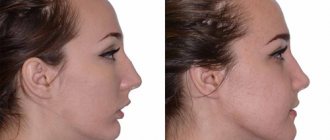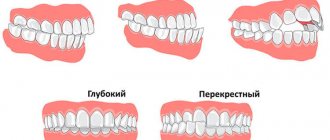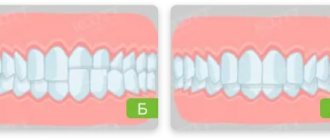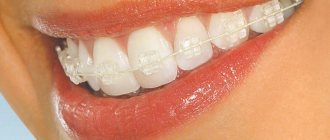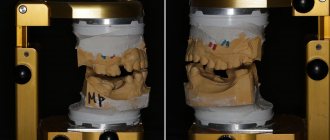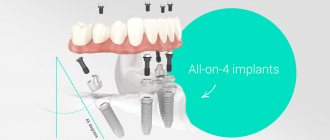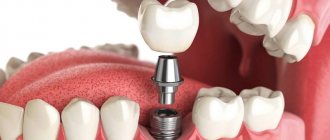Malocclusion is manifested by deformation of the position of the teeth, which grow unevenly. The pathology negatively affects the functions of the dentofacial apparatus, disrupts aesthetics, causes headaches and sleep disturbances. Implants for malocclusion are installed with minor deformation. In case of severe deviations, installation without orthodontic treatment is impossible or involves high risks. The operation will only make the situation worse. If the patient refuses orthodontic treatment, the doctor will refuse implantation.
Is it possible to place implants if there is an incorrect bite?
The possibility of installing implants is assessed based on diagnostic results and depends on the degree of bite deformation. An individual treatment plan is developed for each patient.
Preparation for installation of artificial roots includes a set of diagnostic procedures. The patient is examined by an orthopedic dentist and an orthodontist, who evaluate the condition of the bite. Violations are indicated by unevenly growing teeth, crowding, interdental spaces, and improper closure when biting. To assess the degree of pathology, plate testing and x-ray examination of the jaws are used.
Implantation with malocclusion is complicated, so the patient is offered orthodontic treatment if:
- a significant deformation has been identified in which implantation is impossible and can only cause harm;
- The deformation is insignificant, but the patient wants to achieve ideal smile aesthetics after implantation.
In case of minor violations, it is possible to install an implant without eliminating the deformation. This applies to clinical cases where a person has a slight inclination of the anterior units, a diastema or tremata, or a slight lack of space for a crown on the implant. Before the operation, the doctor discusses the nuances of the procedure with the patient and warns about possible risks.
Materials for the manufacture of structures
Materials can be very different:
- alloys of noble and base metals in pure form,
- metal ceramics,
- solid ceramics,
- zirconium dioxide,
- metal-plastic,
- plastic.
The desire of patients to install crowns in order to correct curvature, shape and position most often arises if the defect is present on the front teeth, which are noticeable to others. If you want to achieve maximum aesthetics specifically in the smile area, and for the result to please you for a long time, then it is better to choose designs made of ceramics and zirconium dioxide, because these materials most accurately imitate the structure, color and shine of enamel. Plus, their appearance does not change throughout their entire service life; they are not stained by food.
“My four front teeth on the upper jaw are healthy, without fillings or holes, but they were crooked. I really wanted a Hollywood smile without flaws and, naturally, as quickly as possible. I asked the doctor if it was possible to straighten them and give them aesthetics with crowns. I was ready to install the best and most expensive ones! But the dentist directly said that she would not take such a sin on her soul, and she would not deprive or file away living, albeit crooked, teeth. Why, he says, do you need this, so that they rot inside and slowly fall apart. Then you’ll take them off in 10 years, you’ll still be young, but you’ll need to remove them. Better, he says, go to the orthodontist. I then thought about it and followed her advice. I wore braces for a year and a half, then retainers for the same amount of time. And, in principle, I was satisfied with the result. The only thing I don’t like now is the color of the enamel, white spots have appeared, I want to bleach it.”
Flo, fragment of a review from the dental portal gidpozubam.ru
Contraindications
Implantation with malocclusion in case of serious violations is not carried out; mandatory treatment by an orthodontist is required first. The surgeon needs to install the implant correctly, which is complicated by the incorrect position of the adjacent teeth. Without eliminating the defect, it is difficult for the orthopedist to achieve the aesthetics of the crown on the installed implant. It is difficult to restore the functions of the dentofacial apparatus. The introduction of an implant and its loading with a prosthesis will only intensify deformation changes. You will have to remove the installed implants and begin orthodontic treatment.
Veneers - surgical correction of tooth defects
When it is necessary in the shortest possible time to correct the position of a deployed, protruded or creeping onto an adjacent tooth, to eliminate the gap between teeth or to disguise extensive fillings, wedge-shaped defects and restorations, microprosthetics with veneers . A miniature, thin ceramic plate is also made from an impression and applied to the front surface of the tooth using a special adhesive composition. The surface of the veneer is indistinguishable from tooth enamel in color and other characteristics.
The possibility of dental treatment and prosthetics under general anesthesia allows you to restore the integrity of teeth with inlays and veneers with minimal discomfort for the patient.
Types of pathologies and the possibility of installing implants
When the bite is imbalanced, the teeth are in the wrong position in the row or the jaws are misaligned. For each clinical case, a treatment regimen is developed:
- With incorrect position of teeth.
The degree of inclination is assessed. If dental roots or crowns do not interfere with the implantation, the operation is performed without alignment. This option is for people who do not have maximum aesthetic requirements. But to achieve a perfect smile, orthodontic treatment will be required before implantation. If the roots of adjacent teeth interfere with the installation of implants, orthodontic treatment must be prescribed. Sometimes doctors resort to surgical removal of “eights” that occupy the wrong position in the jawbone. - When the jaws are displaced.
The degree of anomaly is assessed. If the displacement is insignificant, implantation is possible - the pathology is eliminated using prostheses on implants. If there is a pronounced displacement, implants cannot be installed; it is impossible to achieve a high-quality result.
During orthodontic treatment before implantation, the patient is offered removable dentures for aesthetic restoration of the defect. Due to changes in the bite when wearing braces, dentures will have to be periodically repositioned or replaced.
Ceramic inlay - microinsert that replaces a filling
As you know, before filling a tooth affected by caries, the doctor first excises its non-viable tissue. Therefore, in case of secondary caries, when the filling has to be re-placed, due to the significant size of the cavity, the tooth is already practically destroyed. The patient is recommended to undergo depulpation and cover it with a crown.
Recurrence of caries occurs due to the lack of proper sealing between the walls of the tooth and the composite filling, which decreases in volume during polymerization. The ceramic inlay is free of this drawback; it is manufactured individually with high precision and therefore fits tightly to the tooth. The ceramic material of the inlay does not shrink and does not change color or shape during use.
Microprosthetics with inlays is performed on teeth whose defects make up up to 30% of the volume of their coronal part, and allows you to create exact copies of teeth with the correct shape of the chewing surface.
Consequences of implantation for malocclusion
Patients who neglect orthodontic treatment are more likely to experience complications. The risk of artificial roots being rejected increases due to uneven chewing load.
If the closure of the jaws is impaired, the enamel and cutting edge wear away, and the roots do not have enough nutrition. Implantation increases the imbalance. The result of the operation will be disastrous.
If implants are installed without correcting the bite, the patient will encounter problems:
- loosening of the artificial root, its rejection;
- abrasion of enamel, destruction of living teeth;
- disruption of the jaw joint;
- pain while eating;
- mucosal injuries;
- gum loss;
- violation of diction;
- Difficulties with oral hygiene.
In severe cases, a necessary measure is to remove artificial roots, which increases the duration and cost of treatment due to additional surgical intervention.
Reviews
It is difficult to imagine a person who has not had a single crown installed in his entire life. Mostly these are steel stamped products.
A much smaller number of people wear prostheses made of metal-free ceramics and zirconium oxide. If you are one of them, please share your operating experience.
A few words of comment at the bottom of this page will not take up much of your time, but will be very useful for those who are about to undergo prosthetics.
If you find an error, please select a piece of text and press Ctrl+Enter.
Tags dental crowns bite
Did you like the article? stay tuned
Previous article
What are the best crowns to put on dental implants and why?
Next article
Stages of treatment with braces or getting a perfect smile from A to Z
What to do if the implant is already in place
After implantation, the bite cannot be corrected without complex medical procedures. Artificial roots, unlike natural ones, are absolutely motionless. When trying to correct the position, only your own teeth will change. The implant will remain in its original position.
A person is faced with a difficult choice. With a radical approach, the artificial root is removed, bite deviations are corrected, then the implant is reinstalled and loaded with a crown. The second option is to ignore aesthetic or functional defects.
Sometimes doctors place implants before correcting the bite as part of the treatment plan. After complete engraftment of the metal root, orthodontic treatment begins. With this arrangement, the teeth are attracted or repelled from a fixed support. All stages of therapy are thought out in advance. The scheme must be clearly developed by the implant surgeon together with the orthodontist.
Stage I - treatment by an orthodontist and a neuromuscular dentist, osteopathic correction
Diagnosis by orthodontist O.A. Baranova: deep incisal occlusion, bruxism, increased tooth wear, shift of the midline on the lower jaw to the left, TMJ dysfunction on the left, edentia 35.
Diagnosis of neuromuscular dentist A.V. Galeeva: dysfunction of the masticatory muscles and temporomandibular joints.
Before fixing the braces, neuromuscular dentist A.V. Using a myograph, Galeev determined the physiological and stable musculoskeletal position of the lower jaw. To normalize the bite, the existing height of the lower teeth is not enough, so to fix the position of the lower jaw found using a myograph, the doctor made a removable orthotic. The doctor will monitor, analyze and correct the resulting position until the dental system adapts (usually 2-3 months, it is impossible to give exact dates, since all people have different adaptation capabilities).
Below is a photo of the patient before the start of treatment, and with a removable orthotic on her teeth - the bite is “raised”, the contours of the face have become more harmonious, the nasolabial folds have been smoothed out:
After fixing the correct position of the lower jaw, the orthodontist begins the work. Along with the orthodontist, the patient is treated by an osteopathic doctor.
Diagnosis by osteopath A.I. Popova: descending type of osteopathic disorders caused by malocclusion.
Damon braces are fixed to the teeth of the upper jaw. The goals of treatment at this step are to straighten the upper teeth and normalize the shape of the upper dentition. Braces have not yet been installed on the teeth of the lower jaw, since the orthotic is in the adjustment stage as the position of the upper teeth changes. After stabilizing the position of the upper teeth, the removable orthotic will be replaced with a fixed one, and then braces will be installed on the lower teeth.
After 9 months, the orthodontist fixed braces on the teeth of the lower jaw. Before this, the removable orthotic was replaced with a non-removable one.
In the area of the missing 35th tooth, a spring is installed on the bracket system to expand the gap:
After 4 months, the place for prosthetics is almost prepared.
Orthodontic treatment lasted 1 year 9 months. The bite is normalized, a place for prosthetics has been created, clicks and pain in the TMJ have stopped.
The osteopath performed 10 sessions during the orthodontic treatment. The main directions of correction are relieving excess tension from the bones of the skull, muscles of the neck, face, chewing muscles, adapting the body to changes in the position of the lower jaw, and strengthening the correct functioning of the muscles. Osteopathic correction makes the results of bite correction more stable.
